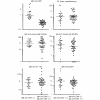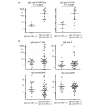Reduced IgG anti-small nuclear ribonucleoprotein autoantibody production in systemic lupus erythematosus patients with positive IgM anti-cytomegalovirus antibodies
- PMID: 19232124
- PMCID: PMC2688261
- DOI: 10.1186/ar2621
Reduced IgG anti-small nuclear ribonucleoprotein autoantibody production in systemic lupus erythematosus patients with positive IgM anti-cytomegalovirus antibodies
Abstract
Introduction: Systemic lupus erythematosus is characterized by production of autoantibodies to RNA or DNA-protein complexes such as small nuclear ribonucleoproteins (snRNPs). A role of Epstein-Barr virus in the pathogenesis has been suggested. Similar to Epstein-Barr virus, cytomegalovirus (CMV) infects the majority of individuals at a young age and establishes latency with a potential for reactivation. Homology of CMV glycoprotein B (UL55) with the U1snRNP-70 kDa protein (U1-70 k) has been described; however, the role of CMV infection in production of anti-snRNPs is controversial. We investigated the association of CMV serology and autoantibodies in systemic lupus erythematosus.
Methods: Sixty-one Mexican patients with systemic lupus erythematosus were tested for CMV and Epstein-Barr virus serology (viral capsid antigen, IgG, IgM) and autoantibodies by immunoprecipitation and ELISA (IgG and IgM class, U1RNP/Sm, U1-70 k, P peptide, rheumatoid factor, dsDNA, beta2-glycoprotein I).
Results: IgG anti-CMV and IgM anti-CMV were positive in 95% (58/61) and 33% (20/61), respectively, and two cases were negative for both. Clinical manifestation and autoantibodies in the IgM anti-CMV+ group (n = 20) versus the IgM anti-CMV(-)IgG+ (n = 39) group were compared. Most (19/20) of the IgM anti-CMV+ cases were IgG anti-CMV+, consistent with reactivation or reinfection. IgM anti-CMV was unrelated to rheumatoid factor or IgM class autoantibodies and none was positive for IgM anti-Epstein-Barr virus-viral capsid antigen, indicating that this is not simply due to false positive results caused by rheumatoid factor or nonspecific binding by certain IgM. The IgM anti-CMV+ group has significantly lower levels of IgG anti-U1RNP/Sm and IgG anti-U1-70 k (P = 0.0004 and P = 0.0046, respectively). This finding was also confirmed by immunoprecipitation. Among the IgM anti-CMV(-) subset, anti-Su was associated with anti-U1RNP and anti-Ro (P < 0.05). High levels of IgG anti-CMV were associated with production of lupus-related autoantibodies to RNA or DNA-protein complex (P = 0.0077).
Conclusions: Our findings suggest a potential role of CMV in regulation of autoantibodies to snRNPs and may provide a unique insight to understand the pathogenesis.
Figures



Similar articles
-
Humoral markers of active Epstein-Barr virus infection associate with anti-extractable nuclear antigen autoantibodies and plasma galectin-3 binding protein in systemic lupus erythematosus.Lupus. 2016 Dec;25(14):1567-1576. doi: 10.1177/0961203316644334. Epub 2016 Apr 15. Lupus. 2016. PMID: 27084029
-
Association of clinical and serological parameters of systemic lupus erythematosus patients with Epstein-Barr virus antibody profile.J Med Virol. 2018 Mar;90(3):559-563. doi: 10.1002/jmv.24904. Epub 2017 Nov 29. J Med Virol. 2018. PMID: 28734074
-
IgM anti-A and D SnRNP proteins and IgM anti-dsDNA are closely associated in SLE sera.Clin Immunol Immunopathol. 1995 Jan;74(1):70-6. doi: 10.1006/clin.1995.1010. Clin Immunol Immunopathol. 1995. PMID: 7527748
-
Acute viral infections in patients with systemic lupus erythematosus: description of 23 cases and review of the literature.Medicine (Baltimore). 2008 Nov;87(6):311-318. doi: 10.1097/MD.0b013e31818ec711. Medicine (Baltimore). 2008. PMID: 19011502 Review.
-
Epstein-Barr virus and systemic lupus erythematosus.Curr Opin Rheumatol. 2006 Sep;18(5):462-7. doi: 10.1097/01.bor.0000240355.37927.94. Curr Opin Rheumatol. 2006. PMID: 16896283 Review.
Cited by
-
Cytomegalovirus infection in childhood-onset systemic lupus erythematosus.Int J Clin Rheumtol. 2013 Feb;8(1):137-146. doi: 10.2217/ijr.12.82. Int J Clin Rheumtol. 2013. PMID: 24527062 Free PMC article.
-
Cytomegalovirus Pneumonia in Patients with Rheumatic Diseases After Immunosuppressive Therapy: A Single Center Study in China.Chin Med J (Engl). 2016 Feb 5;129(3):267-73. doi: 10.4103/0366-6999.174490. Chin Med J (Engl). 2016. PMID: 26831226 Free PMC article.
-
Autoantibodies to transcription intermediary factor TIF1β associated with dermatomyositis.Arthritis Res Ther. 2012 Apr 17;14(2):R79. doi: 10.1186/ar3802. Arthritis Res Ther. 2012. PMID: 22513056 Free PMC article.
-
Differential immunoglobulin class-mediated responses to components of the U1 small nuclear ribonucleoprotein particle in systemic lupus erythematosus and mixed connective tissue disease.Lupus. 2013 Nov;22(13):1371-81. doi: 10.1177/0961203313508444. Lupus. 2013. PMID: 24158973 Free PMC article.
-
High prevalence of autoantibodies to RNA helicase A in Mexican patients with systemic lupus erythematosus.Arthritis Res Ther. 2010;12(1):R6. doi: 10.1186/ar2905. Epub 2010 Jan 8. Arthritis Res Ther. 2010. PMID: 20064217 Free PMC article.
References
-
- Reeves WH, Narain S, Satoh M. Autoantibodies in systemic lupus erythematosus. In: Koopman WJ, Moreland LW, editor. Arthritis and Allied Conditions A Textbook of Rheumatology. 15. Philadelphia: Lippincott Williams and Wilkins; 2005. pp. 1497–1521.
-
- Denman AM. Systemic lupus erythematosus – is a viral aetiology a credible hypothesis? J Infect. 2000;40:229–233. - PubMed
-
- Barzilai O, Ram M, Shoenfeld Y. Viral infection can induce the production of autoantibodies. Curr Opin Rheumatol. 2007;19:636–643. - PubMed
-
- Poole BD, Scofield RH, Harley JB, James JA. Epstein–Barr virus and molecular mimicry in systemic lupus erythematosus. Autoimmunity. 2006;39:63–70. - PubMed
Publication types
MeSH terms
Substances
Grants and funding
LinkOut - more resources
Full Text Sources
Medical
Research Materials

